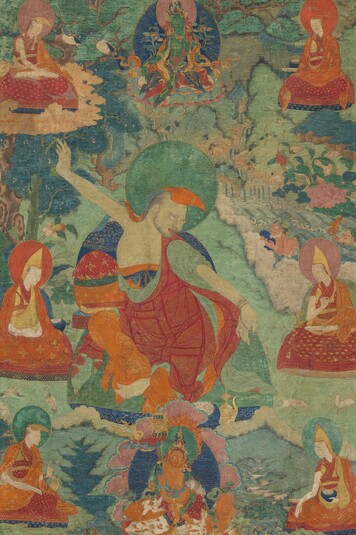
Item: Indian Teacher - Dharmakirti
| Origin Location | Tibet |
|---|---|
| Lineages | Gelug and Buddhist |
| Material | Ground Mineral Pigment on Cotton |
| Collection | Private |
Dharmakirti (?) from a set of nine paintings depicting the Six Ornaments and Two Excellent Ones of the Southern Continent. Each central figure of the nine compositions represent the primary iconographic program of the painting set. The secondary iconographic program is the depiction of the Tibetan teachers of the Kadam and Gelug traditions. The third and final iconographic program is the addition of the deity Tara at the top and the wealth deity Vaishravana at the bottom.

Gyan Drug Chog Nyi (rgyan drug mchog g.nyis):
1. Nagarjuna (slob dpon klu sgrub)
2. Aryadeva ('phags pa arya de va)
3. Asanga ('phags pa thogs med)
4. Vasubhandu (slob dpon dbyig g.nyen)
5. Dignaga (slob dpon phyogs glang)
6. Dharmakirti (slob dpon chos grags)
7. Gunaprabha (slob dpon yon tan 'od)
8. Shakyaprabha (slob dpon shakya 'od)
Surrounding the central figure of Dharmakirti are two deities and six monastic teachers in the lineage of Mahayana philosophy primarily associated with the Kadam lineage of Tibetan Buddhism.
At the top center is Green Tara. At the bottom center is Vaishravana Riding a Lion.
At the top left is Gampopa appearing as a Kadam monk (wearing a yellow Gelug hat). Ne'uzur Yeshe Bar sits at the top right. Three figures remain unidentified because of abrasions and losses to the inscribed name. The figure at the bottom left is Kedrub Sherab Sengge. These figures lived between the 11th and 15th centuries.
Jeff Watt 7-2014
View other items in the Thematic Set: Indian Scholar: Dharmakirti



